Optimal Design and Control of a Spoke-Type IPM Motor with Asymmetric Flux Barriers to Improve Torque Density
Abstract
:1. Introduction
2. Motor Modeling
2.1. Basic Model and Toque Performance
2.2. Proposed Model and Comparison
2.3. Optimal Design
3. Control System Design
3.1. Mathematical Modeling of the Optimal Model
- Ignore the effect of magnetic saturation;
- Ignore the magnetic field harmonics.
3.1.1. Orientation of the Main Flux Linkage Vector
3.1.2. Orientation of the Inductance
3.1.3. Mathematical Model Equation
3.2. Design of the Motor Control System
3.3. Simulation Results
4. Conclusions
Author Contributions
Funding
Institutional Review Board Statement
Informed Consent Statement
Data Availability Statement
Conflicts of Interest
References
- Zhao, W.L.; Chen, D.Z.; Thomas, A.L.; Byung, I.K. Dual airgap stator- and rotor-permanent magnet machines with spoke-type configurations using phase-group concentrated coil windings. IEEE Trans. Ind. Appl. 2017, 53, 3327–3335. [Google Scholar] [CrossRef]
- Chen, D.Z.; Diao, C.W.; Feng, Z.Y.; Zhang, S.C.; Zhao, W.L. Study and design of dual stator permanent magnet machine with spoke-type configurations using phase-group concentrated-coil windings. Int. J. Appl. Electromagn. Mech. 2020, 64, 1381–1389. [Google Scholar] [CrossRef]
- Zhao, S.H.; Chen, J.H.; Gao, Y.P.; Zhang, C. Harmonic and vibration analysis of dual three-phase pmsm with one-phase open circuit fault. Symmetry 2022, 14, 290. [Google Scholar] [CrossRef]
- Maraaba, L.S.; Twaha, S.; Memon, A.; Al-Hamouz, Z. Recognition of stator winding inter-turn fault in interior-mount LSPMSM using acoustic signals. Symmetry 2020, 12, 1370. [Google Scholar] [CrossRef]
- David, G.D.; Min, F.H.; Mircea, P.; Lyndon, E.; David, A.S.; Vic, G. A review of the design issues and techniques for radial-flux brushless surface and internal rare-earth permanent-magnet motors. IEEE Trans. Ind. Electron. 2011, 58, 3741–3757. [Google Scholar]
- Zhao, W.L.; Byung, I.K. Cost-effective permanent magnet shape for reducing cogging torque and torque ripple in surface-mounted permanent magnet machines. Int. J. Appl. Electromagn. Mech. 2016, 52, 817–825. [Google Scholar] [CrossRef]
- Li, J.; Huang, X.Z.; Zhou, B.; Liu, Y.S.; Wang, Z. Research on segmented primary consequent-pole permanent magnet linear synchronous motor with symmetric and periodic end force. Symmetry 2021, 13, 2374. [Google Scholar] [CrossRef]
- Xu, G.H.; Liu, G.H.; Zhao, W.X.; Chen, Q.; Du, X.X. Principle of torque-angle approaching in a hybrid rotor permanent-magnet motor. IEEE Trans. Ind. Electron. 2019, 66, 2580–2591. [Google Scholar] [CrossRef]
- Liu, G.H.; Xu, G.H.; Zhao, W.X.; Du, X.X.; Chen, Q. Improvement of torque capability of permanent-magnet motor by using hybrid rotor configuration. IEEE Trans. Energy Convers. 2017, 32, 953–962. [Google Scholar] [CrossRef]
- Ibrahim, M.; Pillay, P. Aligning the reluctance and magnet torque in permanent magnet synchronous motors for improved performance. In Proceedings of the 2018 IEEE Energy Conversion Congress and Exposition (ECCE), Portland, OR, USA, 23–27 September 2018; pp. 2286–2291. [Google Scholar] [CrossRef]
- Zhao, W.; Zhao, F.; Lipo, T.A.; Kwon, B.I. Optimal design of a novel V-type interior permanent magnet motor with assisted barriers for the improvement of torque characteristics. IEEE Trans. Magn. 2014, 50, 8104504. [Google Scholar] [CrossRef]
- Yang, H.; Wang, W.J.; Lin, H.Y.; Zhu, Z.Q.; Lyu, S.K.; Niu, S.X. A novel hybrid-pole interior PM machine with magnet-axis-shifting effect. In Proceedings of the 2019 IEEE International Electric Machines & Drives Conference (IEMDC), San Diego, CA, USA, 12–15 May 2019; pp. 273–279. [Google Scholar] [CrossRef]
- Rajkumar, S.; Raman, K.S.; Balaji, D.; Kannan, S. High torque to weight ratio and cost estimation of cage induction motor with finite element method for hybrid vehicle. In Proceedings of the 2017 International Conference on Innovative Research In Electrical Sciences (IICIRES), Nagapattinam, India, 16–17 June 2017. [Google Scholar] [CrossRef]
- Takahashi, T.; Takemoto, M.; Ogasawara, S.; Hino, W.; Takezaki, K. Size and weight reduction of an in-wheel axial-gap motor using ferrite permanent magnets for electric commuter cars. IEEE Trans. Ind. Appl. 2017, 53, 3927–3935. [Google Scholar] [CrossRef]
- Guedes-Pinto, P. An axial-flux motor for an electrified world: It combines the best of two motor designs to save weight and energy. IEEE Spectrum 2022, 59, 38–43. [Google Scholar] [CrossRef]
- Yoon, K.; Hwang, K. Optimal design of spoke-type IPM motor allowing irreversible demagnetization to minimize PM weight. IEEE Access 2021, 9, 65721–65729. [Google Scholar] [CrossRef]
- Belkhier, Y.; Achour, A.; Hamoudi, F.; Ullah, N.; Mendil, B. Robust energy-based nonlinear observer and voltage control for grid-connected permanent magnet synchronous generator in the tidal energy conversion system. Int. J. Energy Res. 2021, 45, 13250–13268. [Google Scholar] [CrossRef]
- Belkhier, Y.; Shaw, R.N.; Bures, M.; Islam, M.R.; Bajaj, M.; Albalawi, F.; Alqurashi, A.; Ghoneim, S.S.M. Robust interconnection and damping assignment energy-based control for a permanent magnet synchronous motor using high order sliding mode approach and nonlinear observer. Energy Rep. 2022, 8, 1731–1740. [Google Scholar] [CrossRef]
- Dianov, A.; Tinazzi, F.; Calligaro, S.; Bolognani, S. Review and Classification of MTPA Control Algorithms for Synchronous Motors. IEEE Trans. Power Electr. 2022, 37, 3990–4007. [Google Scholar] [CrossRef]
- Uddin, M.N.; Radwan, T.S.; Rahman, M.A. Performance of Interior Permanent Magnet Motor Drive Over Wide Speed Range. IEEE Trans. Energy Convers. 2002, 17, 79–84. [Google Scholar] [CrossRef]
- Pan, C.T.; Sue, S.M. A Linear Maximum Torque Per Ampere Control for IPMSM Drives Over Full-speed Range. IEEE Trans. Energy Convers. 2005, 20, 359–366. [Google Scholar] [CrossRef]
- Thike, R.; Pillay, P. Mathematical model of an interior pmsm with aligned magnet and reluctance torques. IEEE Trans. Trans. Electrif. 2020, 6, 647–658. [Google Scholar] [CrossRef]
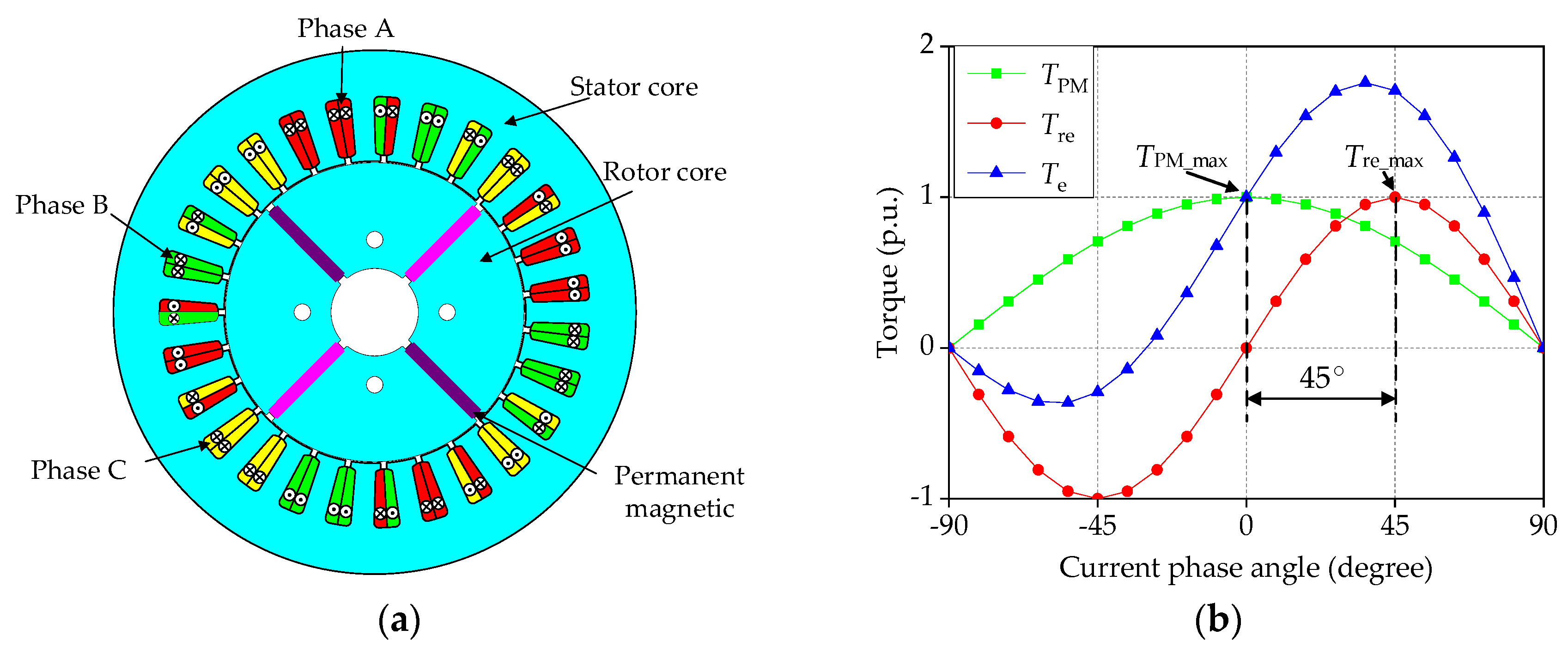
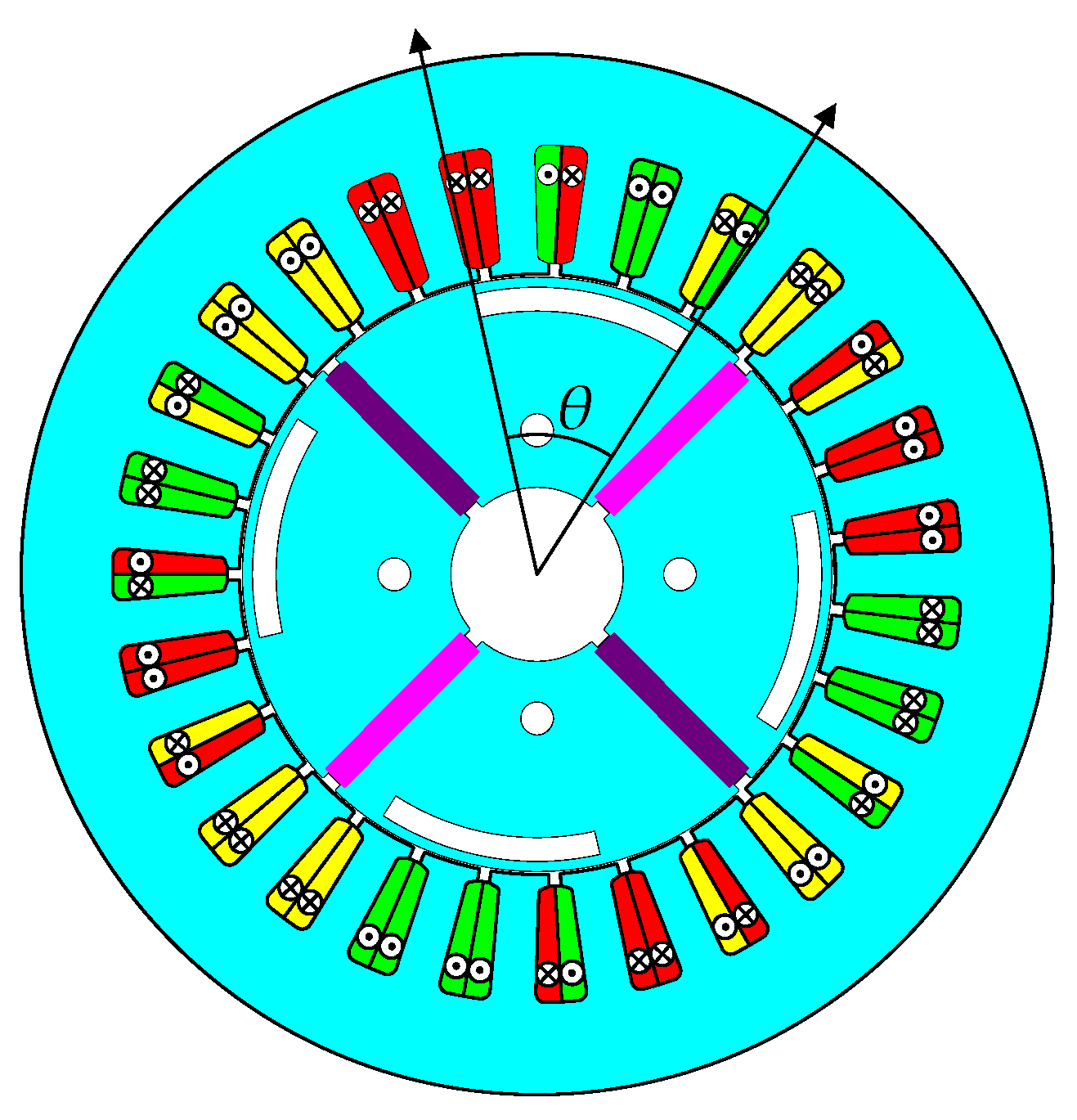
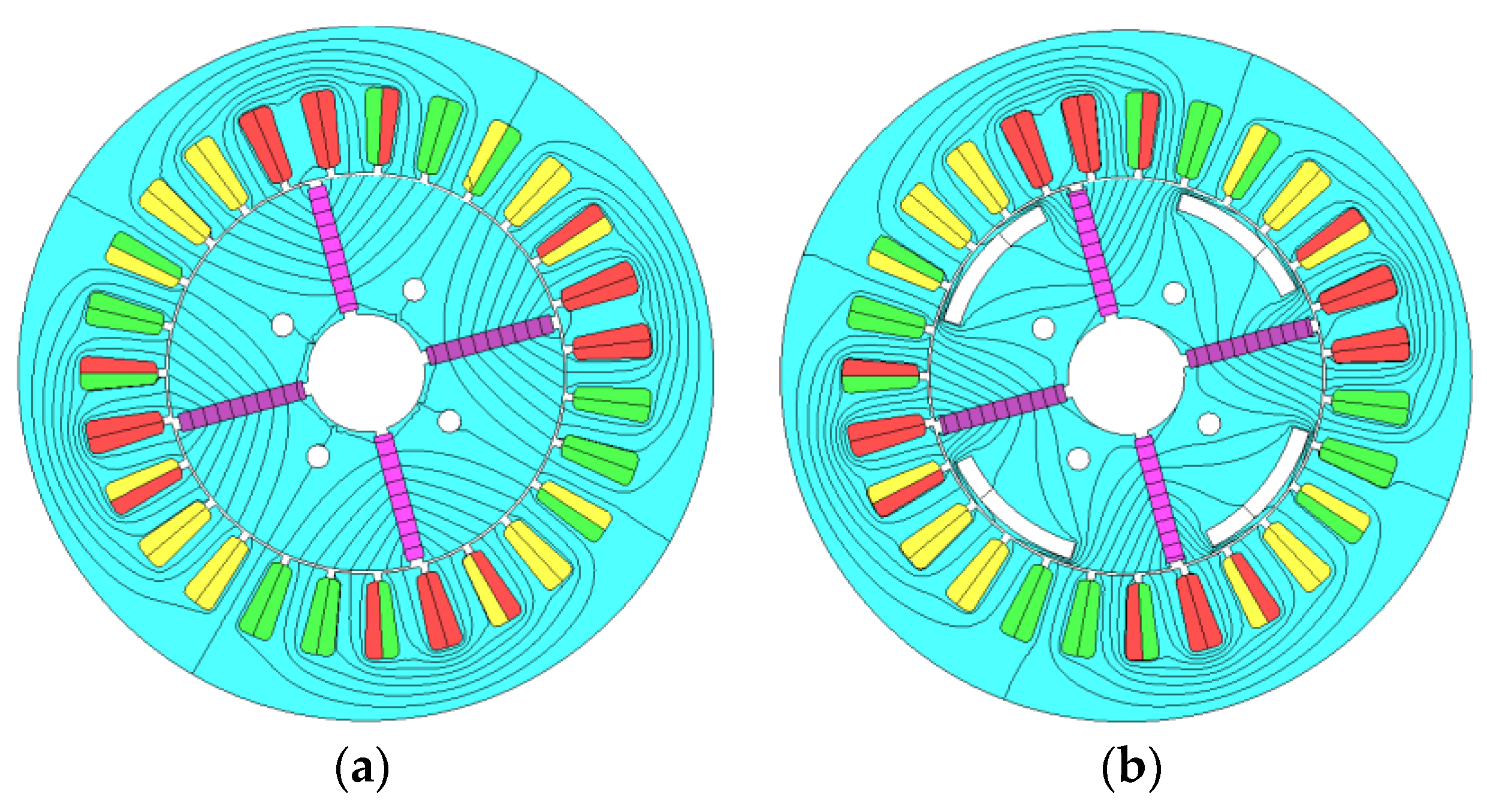
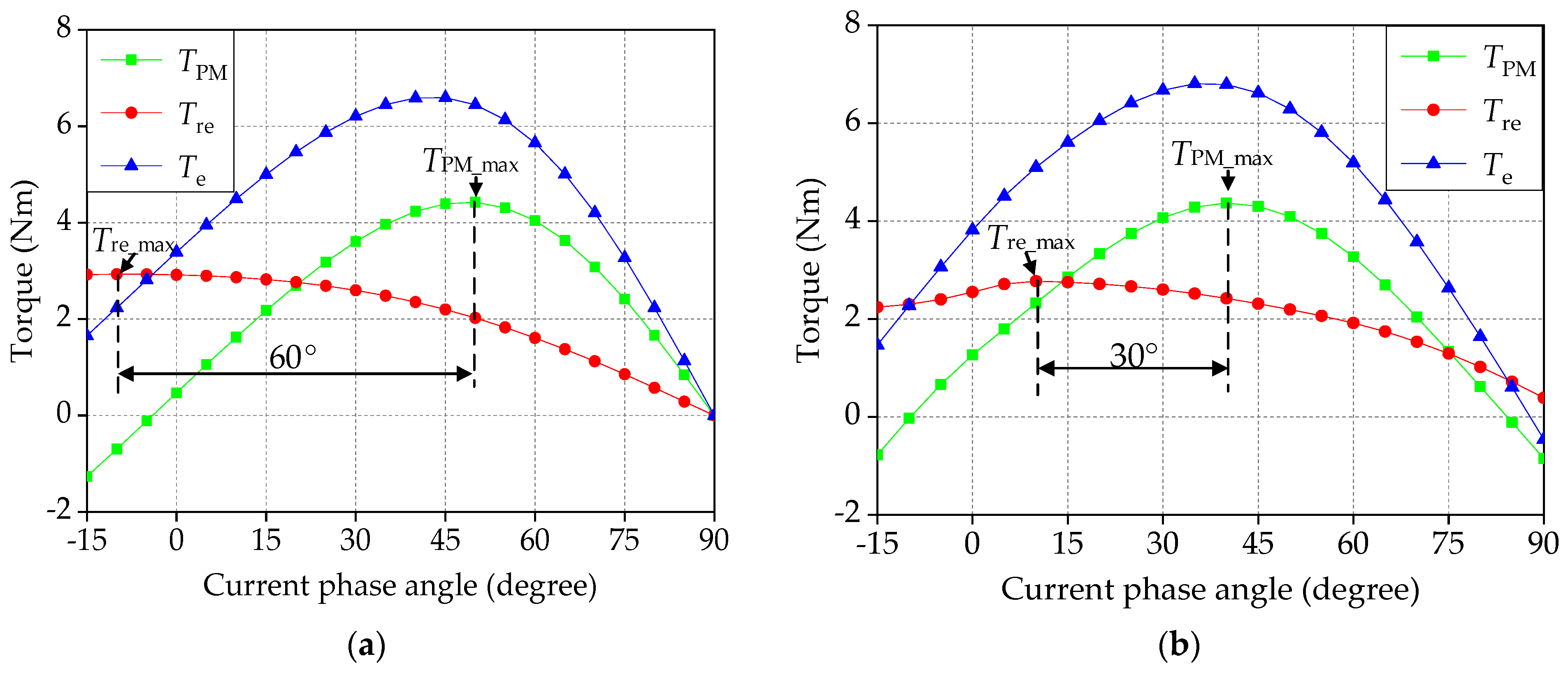




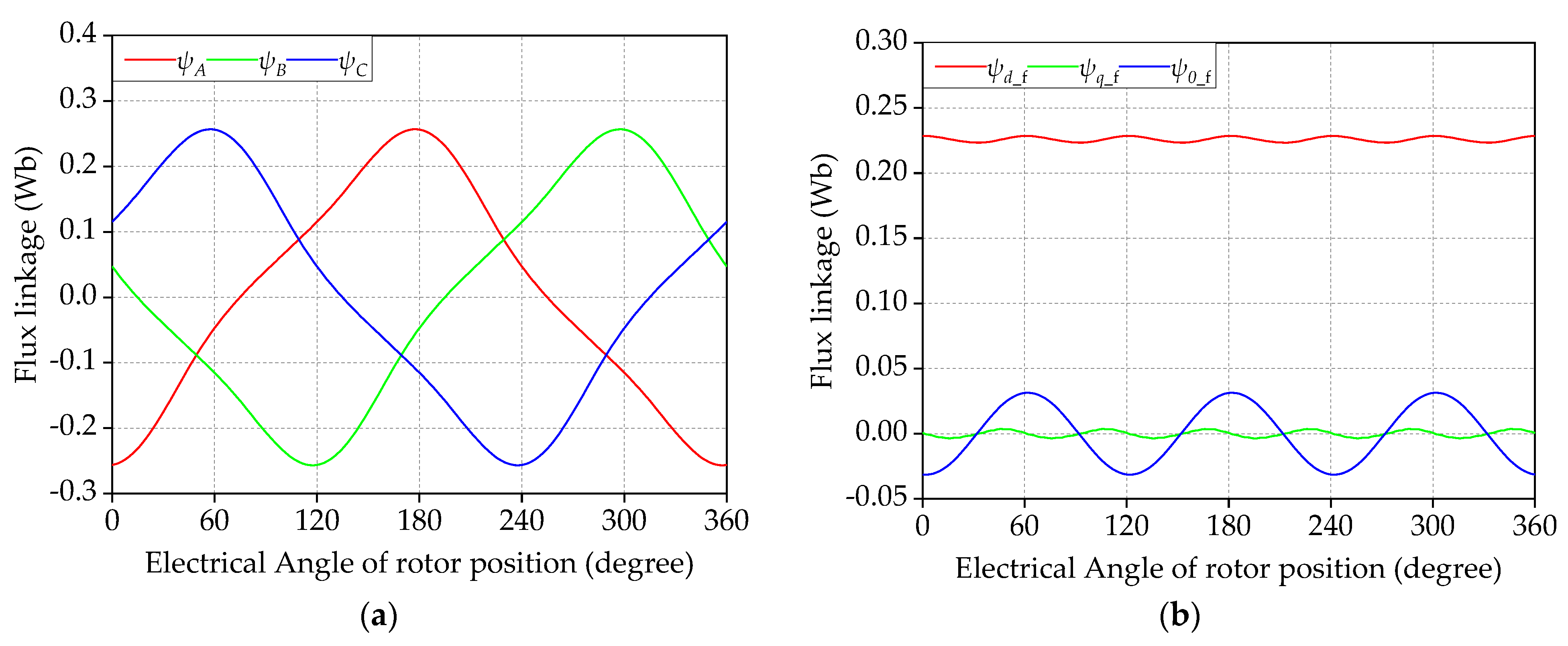
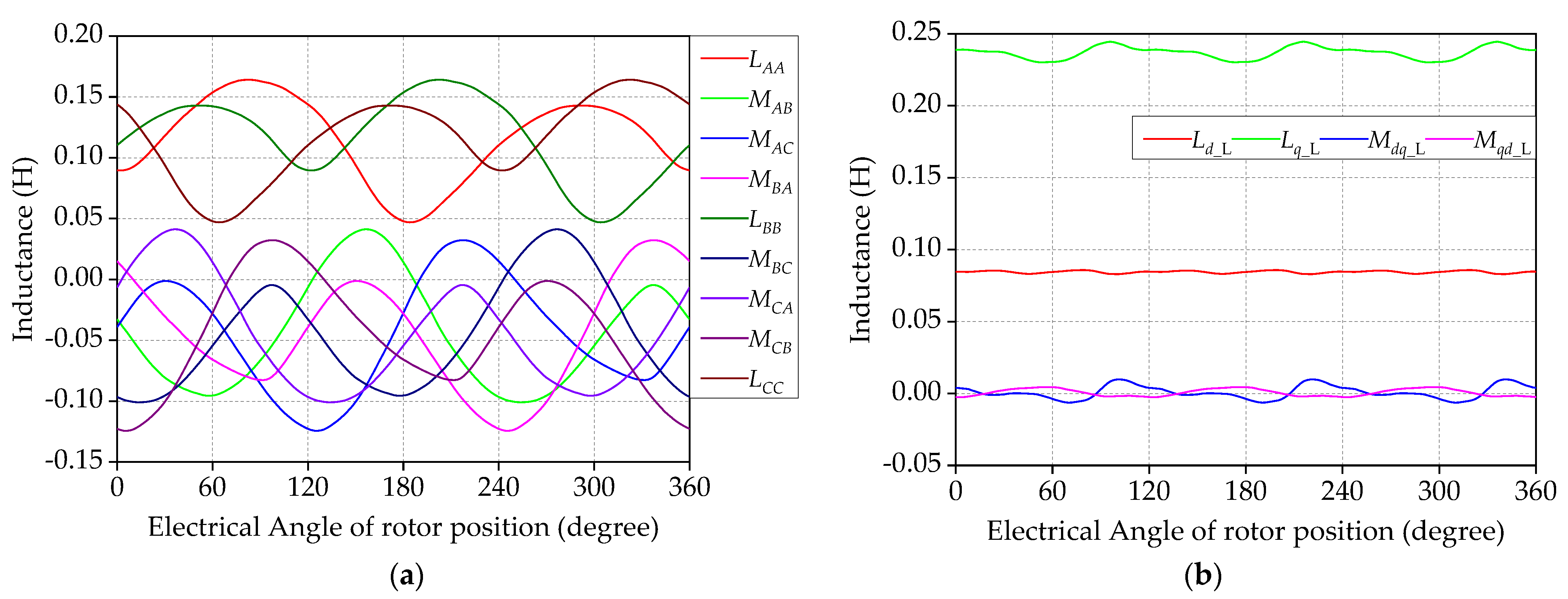
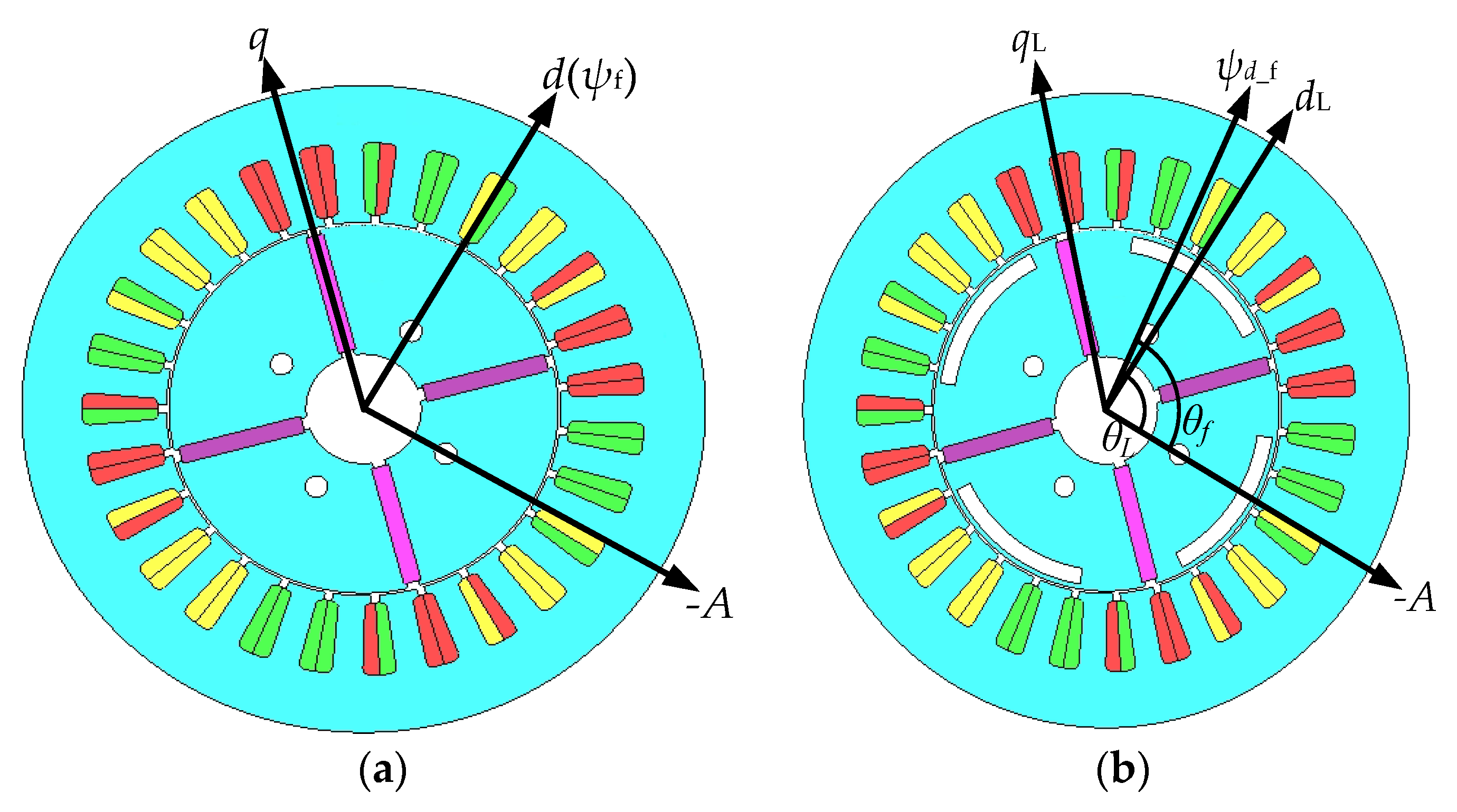
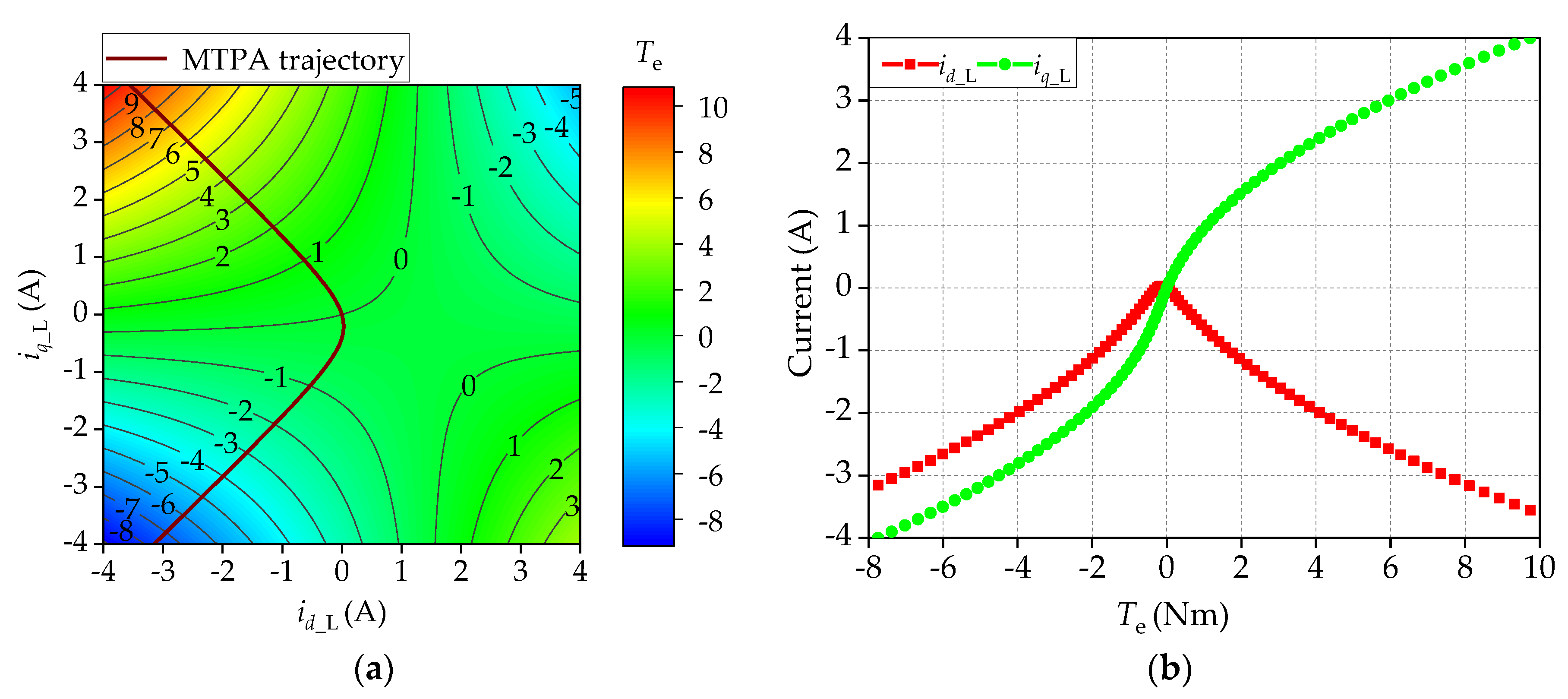
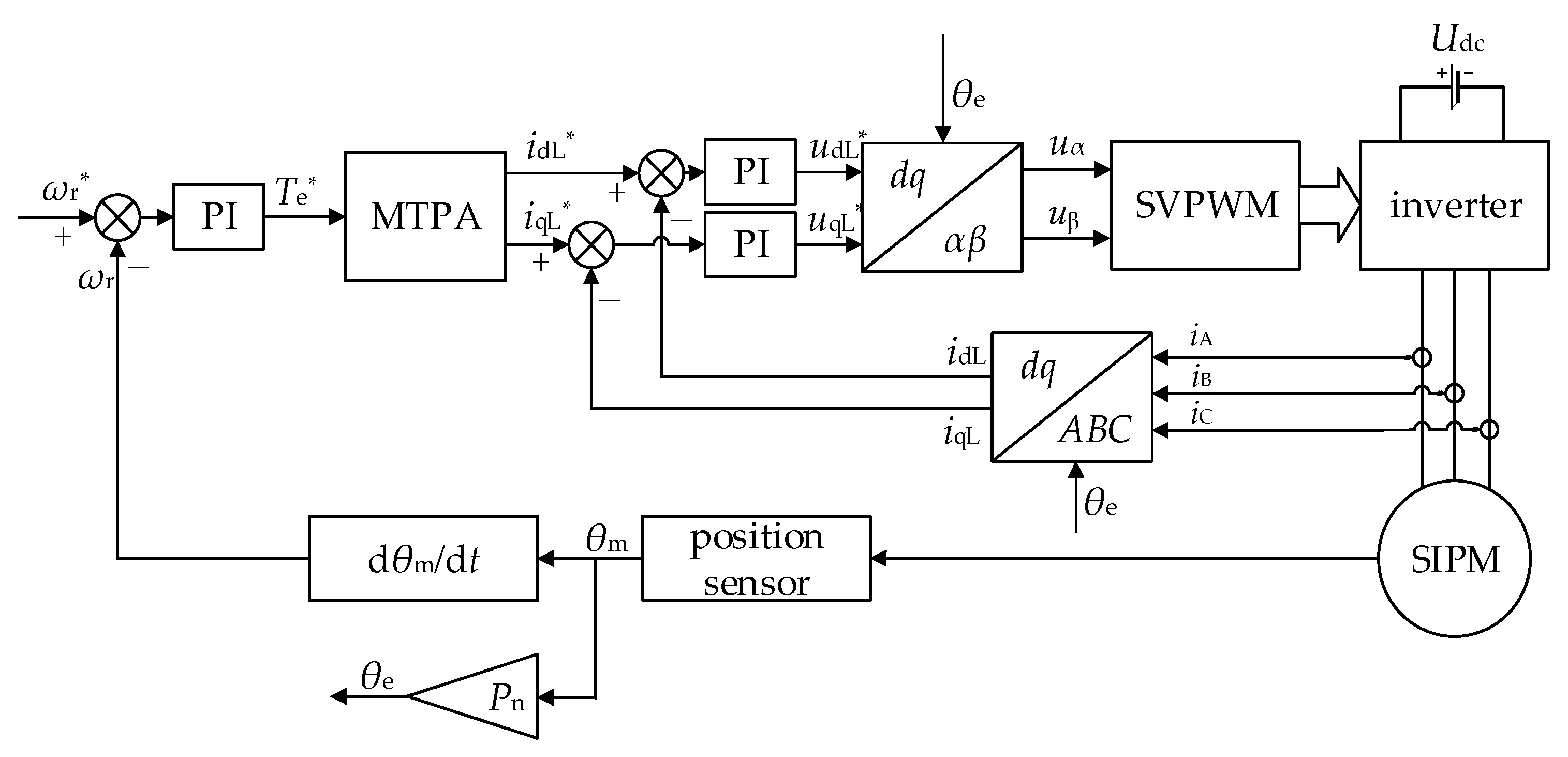
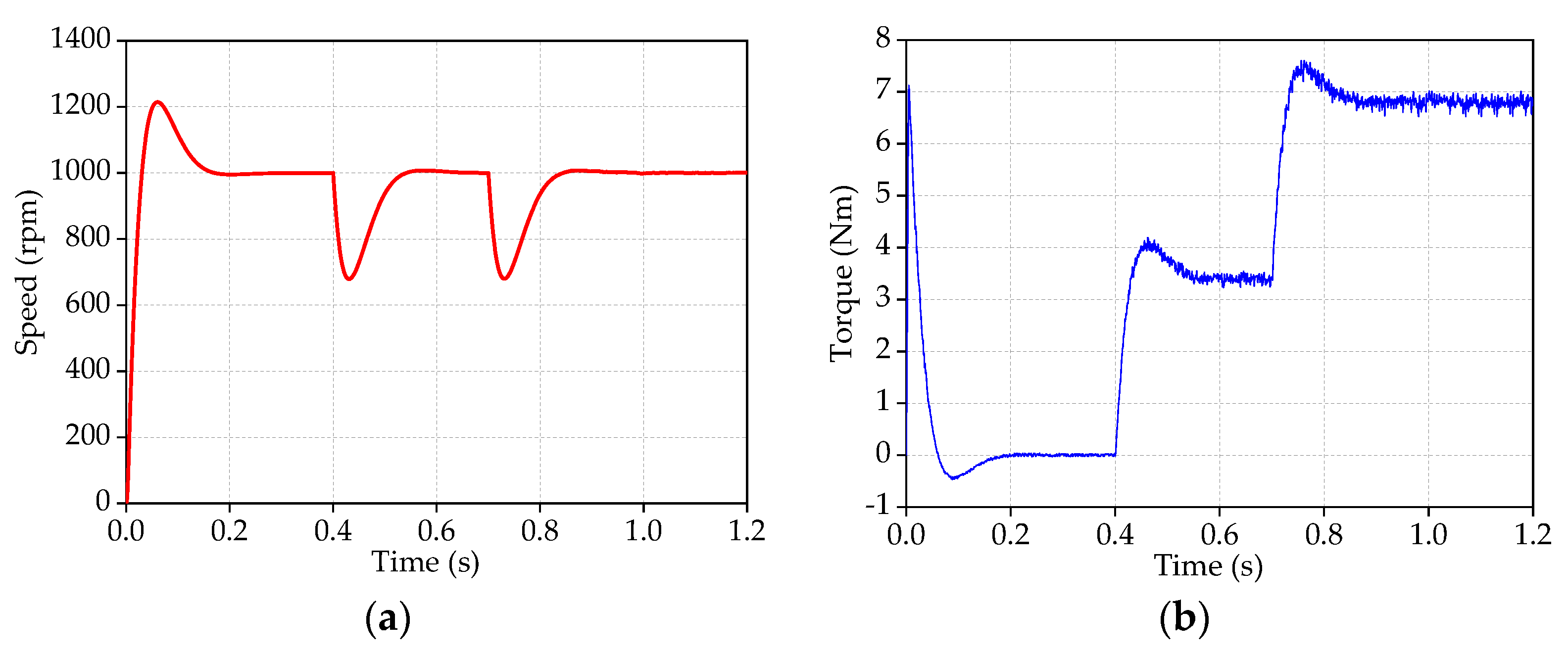
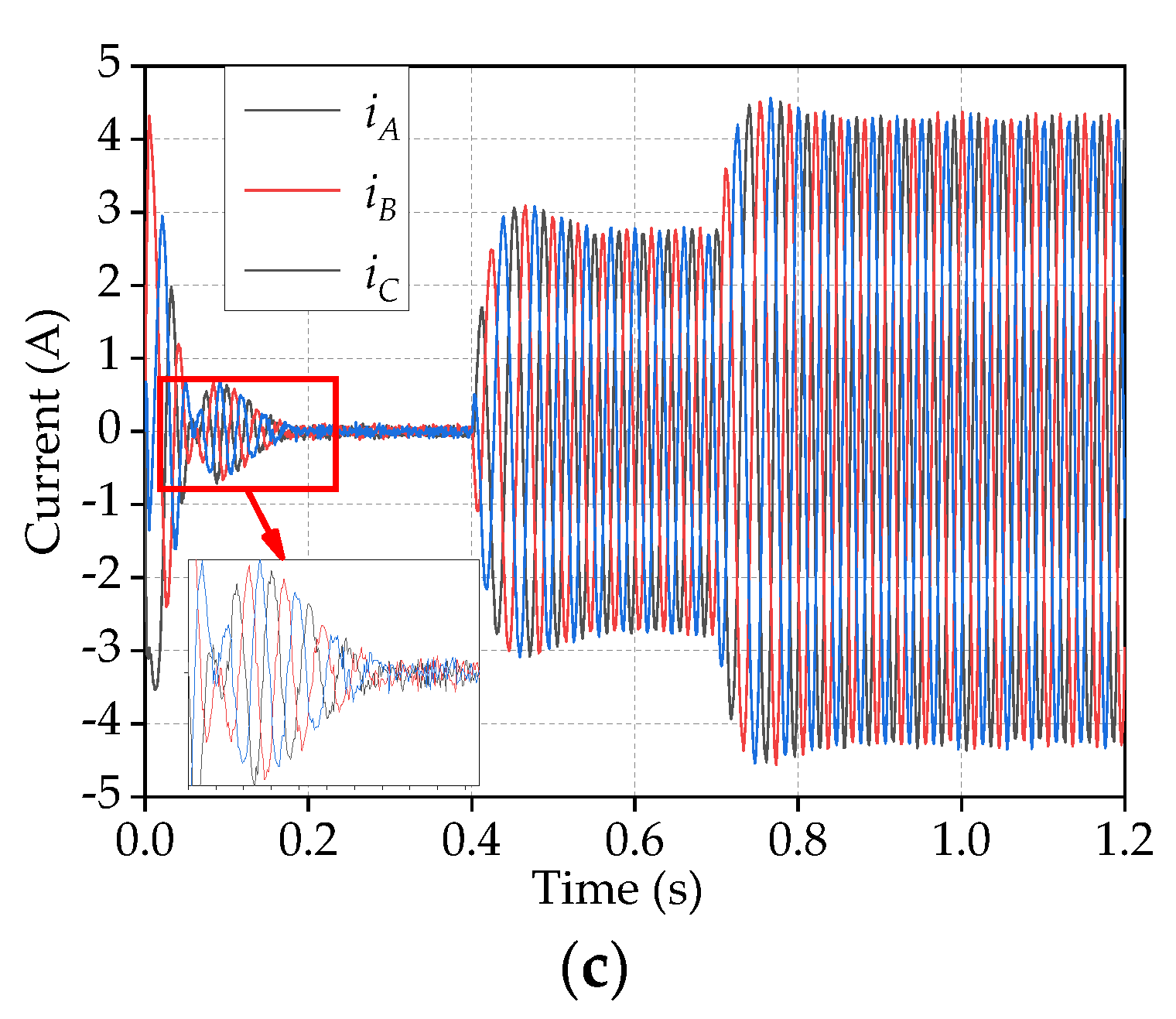

| Item | Unit | Value |
|---|---|---|
| Magnet poles/Stator slots | - | 4/27 |
| Stator outer diameter | mm | 130 |
| Rotor outer diameter | mm | 74 |
| Motor axial length | mm | 75 |
| Airgap length | mm | 0.5 |
| Remanence of magnet | T | 0.4 |
| Rated speed | rpm | 1000 |
| Rated peak current | A | 4 |
| Item | Unit | Basic Model | Proposed Model |
|---|---|---|---|
| Rotor weight | kg | 2.152 | 1.945 |
| Max. torque (Average) | Nm | 6.646 | 6.881 |
| Torque ripple | % | 11.659 | 9.991 |
| Torque density | Nm/kg | 3.088 | 3.538 |
| Output power | W | 696.074 | 720.652 |
| Efficiency | % | 93.936 | 94.092 |
| Item | Unit | Proposed Model | Optimal Model |
|---|---|---|---|
| Rotor weight | kg | 1.945 | 1.909 |
| Max. torque (Average) | Nm | 6.881 | 6.862 |
| Torque density | Nm/kg | 3.538 | 3.595 |
| EMF (RMS) | V | 39.581 | 36.241 |
| Item | Unit | Value |
|---|---|---|
| Phase resistance | Ω | 2.04 |
| Number of pole pairs | - | 2 |
| No-load flux linkage | Wb | 0.2259 |
| Moment of inertia | kg·m2 | 0.001274 |
| Direct axis inductance | H | 0.0845 |
| Quadrature inductance | H | 0.237 |
| Motor sampling time | μs | 25 |
| Inverter sampling time | μs | 25 |
| Current loop sampling time | μs | 50 |
| Speed loop sampling time | μs | 500 |
| Quadrature current loop Kp | - | 1066.5 |
| Quadrature current loop Ki | - | 9180 |
| Direct axis current loop Kp | - | 380.25 |
| Direct axis current loop Ki | - | 9180 |
| Speed loop Kp | - | 0.0072 |
| Speed loop Ki | - | 0.16 |
Publisher’s Note: MDPI stays neutral with regard to jurisdictional claims in published maps and institutional affiliations. |
© 2022 by the authors. Licensee MDPI, Basel, Switzerland. This article is an open access article distributed under the terms and conditions of the Creative Commons Attribution (CC BY) license (https://creativecommons.org/licenses/by/4.0/).
Share and Cite
Wu, H.; Zhao, W.; Zhu, G.; Li, M. Optimal Design and Control of a Spoke-Type IPM Motor with Asymmetric Flux Barriers to Improve Torque Density. Symmetry 2022, 14, 1788. https://doi.org/10.3390/sym14091788
Wu H, Zhao W, Zhu G, Li M. Optimal Design and Control of a Spoke-Type IPM Motor with Asymmetric Flux Barriers to Improve Torque Density. Symmetry. 2022; 14(9):1788. https://doi.org/10.3390/sym14091788
Chicago/Turabian StyleWu, Hao, Wenliang Zhao, Gefei Zhu, and Min Li. 2022. "Optimal Design and Control of a Spoke-Type IPM Motor with Asymmetric Flux Barriers to Improve Torque Density" Symmetry 14, no. 9: 1788. https://doi.org/10.3390/sym14091788




